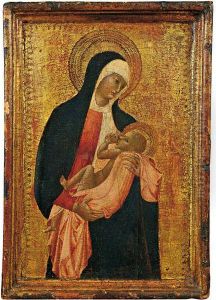Stefano Giovanni Di Sassetta Paintings
Stefano di Giovanni, better known as Sassetta, was an Italian painter of the Sienese school during the early Renaissance. He was born around 1392 in Siena, Italy, and is considered one of the most significant artists of the 15th century in Siena. His work is characterized by its use of vibrant colors, elegant figures, and a combination of Gothic and Renaissance elements, which contributed to the unique style of the Sienese school.
Sassetta's early life and training are not well documented, but it is believed that he was apprenticed to a local painter, perhaps Paolo di Giovanni Fei, which would explain the noticeable influence of the Sienese Gothic style in his work. By the 1420s, Sassetta had become a master in his own right, receiving numerous commissions from religious and civic institutions. His notable early works include the polyptych for the church of San Domenico in Cortona, painted around 1423-26, and the Arte della Lana altarpiece, commissioned for the church of San Francesco in Siena.
Throughout his career, Sassetta worked on several important commissions that showcased his ability to blend the International Gothic style with emerging Renaissance principles. Notably, his 'Sansepolcro Altarpiece' (1437–44) was a monumental work for the Church of San Francesco in Sansepolcro, displaying a sophisticated use of perspective and a more naturalistic approach to figures and landscapes. Unfortunately, many panels of this altarpiece have been dispersed to various museums.
Sassetta's most celebrated work is the 'Borgo San Sepolcro Altarpiece', completed in 1444. The altarpiece is renowned for its narrative quality and the harmonious integration of complex theological concepts with charming scenic details. It is in this work that Sassetta's mastery of color and light is most evident, as he creates a spiritual and poetic atmosphere that is distinct from his contemporaries.
The painter's style continued to evolve over the years, and his later works, such as 'The Journey of the Magi' (1433-35), exhibit a greater sense of spatial depth and a softer modeling of figures. These characteristics would influence later Sienese artists and contribute to the transition from the Gothic to the Renaissance style in the region.
Sassetta's contribution to art extends beyond his paintings. He was part of a vibrant community of artists and intellectuals in Siena, and his influence can be seen in the works of subsequent generations of Sienese painters. His ability to synthesize the ornamental Gothic tradition with the emerging naturalism of the Renaissance made him a pivotal figure in the development of Sienese art.
Sassetta died in 1450, and his exact burial place is not known. Despite this, his legacy endures through his artworks that can be found in prestigious institutions worldwide, such as the Louvre, the Metropolitan Museum of Art, and the National Gallery in London. Sassetta remains a central figure in the study of Italian Renaissance art, particularly within the context of the Sienese school's evolution throughout the 15th century.
